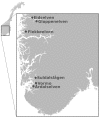The vgll3 Locus Controls Age at Maturity in Wild and Domesticated Atlantic Salmon (Salmo salar L.) Males
- PMID: 26551894
- PMCID: PMC4638356
- DOI: 10.1371/journal.pgen.1005628
The vgll3 Locus Controls Age at Maturity in Wild and Domesticated Atlantic Salmon (Salmo salar L.) Males
Abstract
Wild and domesticated Atlantic salmon males display large variation for sea age at sexual maturation, which varies between 1-5 years. Previous studies have uncovered a genetic predisposition for variation of age at maturity with moderate heritability, thus suggesting a polygenic or complex nature of this trait. The aim of this study was to identify associated genetic loci, genes and ultimately specific sequence variants conferring sea age at maturity in salmon. We performed a genome wide association study (GWAS) using a pool sequencing approach (20 individuals per river and phenotype) of male salmon returning to rivers as sexually mature either after one sea winter (2009) or three sea winters (2011) in six rivers in Norway. The study revealed one major selective sweep, which covered 76 significant SNPs in which 74 were found in a 370 kb region of chromosome 25. Genotyping other smolt year classes of wild and domesticated salmon confirmed this finding. Genotyping domesticated fish narrowed the haplotype region to four SNPs covering 2386 bp, containing the vgll3 gene, including two missense mutations explaining 33-36% phenotypic variation. A single locus was found to have a highly significant role in governing sea age at maturation in this species. The SNPs identified may be both used as markers to guide breeding for late maturity in salmon aquaculture and in monitoring programs of wild salmon. Interestingly, a SNP in proximity of the VGLL3 gene in humans (Homo sapiens), has previously been linked to age at puberty suggesting a conserved mechanism for timing of puberty in vertebrates.
Conflict of interest statement
The authors have declared that no competing interests exist.
Figures



References
-
- Olsen RE, Skilbrei OT (2010) Feeding preference of recaptured Atlantic salmon Salmo salar following simulated escape from fish pens during autumn. Aquaculture Environment Interactions 1: 167–174.
-
- Wild V, Simianer H, Gjoen HM, Gjerde B (1994) Genetic-Parameters and Genotype X Environment Interaction for Early Sexual Maturity in Atlantic Salmon (Salmo-Salar). Aquaculture 128: 51–65.
Publication types
MeSH terms
Substances
LinkOut - more resources
Full Text Sources
Other Literature Sources
Medical

